Takeda Next we’d like to move to the six Honorable Mention winners. I’d like Mr. Christensen to make comments on the work by Masayo Odahashi.
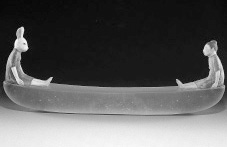 Christensen Masayo Odahashi is one of the quite many Japanese glass artists who have won recognition outside of Japan last year. It is amazing to see how Japanese glass artists have played an important roll in the exhibitions and in the modern glass world. It was obvious also that at the International Exhibition of Glass Kanazawa Japanese artists’ pieces are very important. As the level of the pieces is so high generally, the artists who won higher prizes at this exhibition should have won higher prizes at another competition. Here they have also, of course, something to take with them from the exhibition. Other than higher prizes, giving the honorary mentions is a good thing.
Christensen Masayo Odahashi is one of the quite many Japanese glass artists who have won recognition outside of Japan last year. It is amazing to see how Japanese glass artists have played an important roll in the exhibitions and in the modern glass world. It was obvious also that at the International Exhibition of Glass Kanazawa Japanese artists’ pieces are very important. As the level of the pieces is so high generally, the artists who won higher prizes at this exhibition should have won higher prizes at another competition. Here they have also, of course, something to take with them from the exhibition. Other than higher prizes, giving the honorary mentions is a good thing.
In this case, we have seen this artist more times outside Japan. Again it is a work which has a lot of philosophy behind it. It is a person who is sailing not only on the ocean but in a way sailing of the life also, and he is looking for his soul in taking for often an animal. It is not up to me to go very deep into this philosophy in it. I see this work as a very beautiful, aesthetic piece of art. But one thing in it is that you have also an element of humor, you have an element of story-telling in it. It is also something characteristic for the part of beautiful, aesthetic piece of art. But one thing in it is that you have also an element of humor, you have an element of story-telling in it. It is also something characteristic for the part of he modern glass art that you use the glass as the thing which expresses those arts. I was very happy to see and recognize this artist and the work in this exhibition.
Takeda Thank you. Next I’d like Mr. Myers to make comments on the work from Estonia.
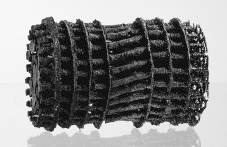 Myers When I began to look around, this piece almost jumped off the table and it hit me in the head. I could easily have given this piece even if it had enough points, the Grand Prize. Perhaps from what you’ve heard me say that you may begin to see something in this piece that will appeal to me.
Myers When I began to look around, this piece almost jumped off the table and it hit me in the head. I could easily have given this piece even if it had enough points, the Grand Prize. Perhaps from what you’ve heard me say that you may begin to see something in this piece that will appeal to me.
This is done by a woman in Estonia which is somewhat out of the general glass world. That is to say, they are more isolated and have little less but a growing experience in the glass scene there. But it is hard to know where this process began. I find it maybe because I like black glass. But this is such a strong form. You are not seeing the full dimension of it because you don’t have a light penetrating through the grid of this piece because it is like penetrating through it. So it could almost be some ancient lyric, maybe some form of wheel or spoke or accel. For me it’s a mystery as to what it is although I don’t care what it is. And the starkness, the form itself, the quality of glass, the gridiness that to me is another way that one can think about using glass. Now I know that even you can think of glass, the winner last time in the competition was the piece that had a great deal about a kind of qualities of glass that direction and perhaps the Grand Prize equally. But this piece is so alive and I wonder what all of you think about because you have to see this piece in front of it. Some of the characteristics come through but not all. Thank you.
Takeda Thank you. Next I’d like Mr. Myers to make comments on the work by Mark Peiser from the USA
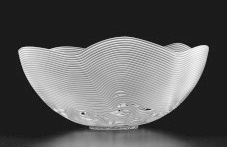 Myers This piece, quite a large piece, it was made by an American glass artist who is a collegue of mine who have known for many years and who is close to 70 years old. This is very new work for him within the last two years. He has found and experimented with the process of making forms by using glass lines, that are cast into a form. Very inventive. And when I see the work, I can only say that I think that the deal of volume, space, and represent to me linear study of single line running through and defining a form.
Myers This piece, quite a large piece, it was made by an American glass artist who is a collegue of mine who have known for many years and who is close to 70 years old. This is very new work for him within the last two years. He has found and experimented with the process of making forms by using glass lines, that are cast into a form. Very inventive. And when I see the work, I can only say that I think that the deal of volume, space, and represent to me linear study of single line running through and defining a form.
Takeda This is quite a large piece. The black piece from Estonia before this is rather small. When you look at the real piece, you can grasp its sizes and concept.
Next I’d like Mr. Harcuba to make comments on the work by Kari Molstad from Norway.
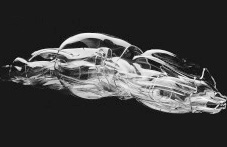 Harcuva Another woman from Norway Kari Molstad she is a glass blower and she used the parts of blown vessels which were completed to create sculpture which is called “Flow”. It’s about movement, it’s about nature, it’s about human activity and it is, the most of all, a picture of a floating boat. You can think about the water flow or jumping fish, something created to water. And the clear glass creates this illusion of running water.
Harcuva Another woman from Norway Kari Molstad she is a glass blower and she used the parts of blown vessels which were completed to create sculpture which is called “Flow”. It’s about movement, it’s about nature, it’s about human activity and it is, the most of all, a picture of a floating boat. You can think about the water flow or jumping fish, something created to water. And the clear glass creates this illusion of running water.
Takeda Next piece is applied by Yuichi Saito from Yamanashi. I’d like Mr. Christensen to make comments on this.
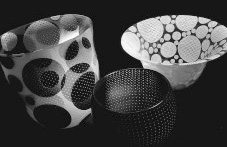 Christensen You can be fascinated with those works here also because it is a sample of glass which have been blown directly before the furnace. It is not in that much today where many different techniques are used for finishing the glass.
Christensen You can be fascinated with those works here also because it is a sample of glass which have been blown directly before the furnace. It is not in that much today where many different techniques are used for finishing the glass.
But here you have a good sample of fundamental thing in glass art that you can be creative directly before the furnace and blow up the glass. So it will often then fall out more of this functional forms but it gives good backgrounds for working with ornamentation in the glass. And it is my opinion very successful use of glass in the case here.
Takeda This work is also quite big. I’d like Mr. Yokoyama to make comments on the work by Blanlka from the Czech Republic.
 Yokoyama When I looked at this work for the first time, I felt that this is an excellent piece. Although it’s titled “THE DREAM”, it reminds me of the wings of Nike of “La Victoire de Samothrace” at the Louver Museum.
Yokoyama When I looked at this work for the first time, I felt that this is an excellent piece. Although it’s titled “THE DREAM”, it reminds me of the wings of Nike of “La Victoire de Samothrace” at the Louver Museum.
The wing has a beautiful touch of clay and a very organic form. It’s supported by the inorganic form. There’s something aesthetic in the way of polishing the surface. The contrast between something organic and something inorganic makes this piece as pretty as a painting.

